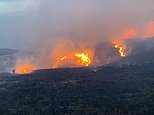Country diary: A liquid call from above, a song of resilience | Claire Stares
<p><strong>Langstone, Hampshire:</strong> A singing skylark isn’t unusual this time of year, and is testament to its adaptability in a changing landscape</p><p>Southmoor nature reserve has always belonged to water. Historically a mosaic of marsh and grazing, crisscrossed by narrow watercourses and used for watercress cultivation in the 19th century, it is now returning to the sea. In September 2020, the crumbling sea defences succumbed to a series of storms, flooding the reserve. At high tide, the sea now slips across the breached seawall, reclaiming the land, and over the past five years, the coastal plain has surrendered to saltwater and seaweed. The marsh isn’t vanishing – it’s becoming something else, something wilder.</p><p>It’s low tide when we set out to walk the perimeter path. In the shelter of the harbour, a flock of brent geese, newly arrived from the tundra of northern Siberia, call softly as they graze alongside teal and wigeon. Along the waterline, dunlin scurry at the feet of oystercatchers and redshanks, the waders’ bills stitching the intertidal mud in search of molluscs, worms and tiny crustaceans.</p> <a href="https://www.theguardian.com/environment/2025/oct/16/country-diary-a-liquid-call-from-above-a-song-of-resilience">Continue reading...</a>
Read original
The Guardian



